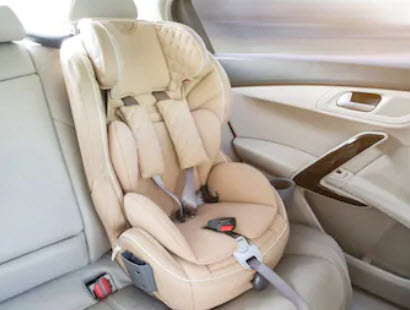Car Seat Safety

We all want the best for our children and we try our best to make sure that our kids are safe. However, car crashes remain a leading cause of death among children ages 1 to 13. In many of these cases, simple errors regarding the choice of car or boosters seat or their installation are responsible for fatalities. By taking the time to understand the types of car seats and making sure that they match the needs of your child, making sure they are correctly used and installed, you can significantly reduce the risk of harm to your child. While no one ever intends to be in a car accident, it is helpful to have the peace of mind of knowing that even if the worst happens, your child has the maximum amount of protection. The National Highway Safety Administration (NHTSA) estimates that 325 children under the age of 5 are saved by the use of car seats every year.
Choosing the Right Car or Booster Seat for Your Child
The NHTSA has an online calculator that you can use to determine the appropriate car or booster seat for your child based on their age, height, and weight. It’s important to understand that as your child grows, the way that they sit in a car seat will change. Many parents are surprised by how often they have to adjust or switch car seats in their child’s early years. However, checking in regularly to make sure that the car seat you are using fits your child’s current weight, size, and safety needs, is critical to ensuring that they have adequate protection in the event of a crash. It’s also important to make sure that in addition to being a good fit for your child, the seat is a good fit for your car. Not all car seat models are compatible with all vehicle models. Particularly if you will be switching a car seat between vehicles (such as between parents or with a childcare provider) it’s important to make sure that the car seat is compatible with all vehicle models. An incompatible car seat will not operate as intended.
In almost all cases, a rear-facing car seat will be the safest car seat for an infant to use. Unlike other car seat models, a rear-facing model has a harness and cradles and moves with the infant in the event of a crash. This motion helps reduce the risk of damage to an infant’s neck and spinal cord, which are particularly vulnerable. Some rear-facing car seats models are convertible and can be transitioned to a forward-facing model as the child outgrows the rear-facing functionality. All-in-one models can also serve as a booster seat once the child outgrows the rear-facing and front-facing car seat functionalities.
Fire Department Resources and Safety Seats
Many people do not know that your local fire department may have a program to inspect your car seat, and maybe even assist in installing it. Many fire departments also have instructional resources to help you choose and maintain your car seat properly. They provide this at no charge to you.
Car Seats Must be Replaced After a Car Crash
Car seats are only good for one collision. Most are designed with components akin to your car’s crumple zones. Once a car seat has been involved in a collision it may lose it effectiveness in protecting your child. Many people do not know the car seats must be replaced, and even fewer know that the at-fault driver’s insurer must pay for its replacement, just like any other property damage.
Talk to a Maryland Personal Injury Lawyer
If you or your child have been injured in a car accident that was not your fault, the experienced Maryland personal injury attorneys at Berman | Sobin | Gross LLP are ready to fight for you and ensure that you get the compensation and support that you are entitled to. Call today to schedule a free consultation.
Resource:
nhtsa.gov/equipment/car-seats-and-booster-seats#find-compare-seats
